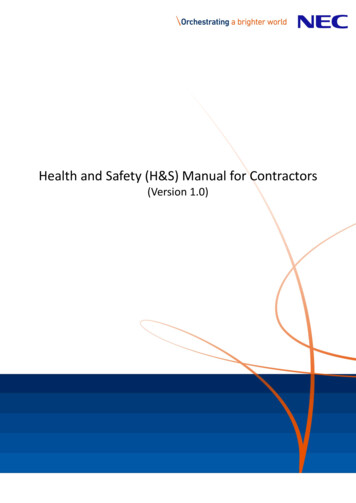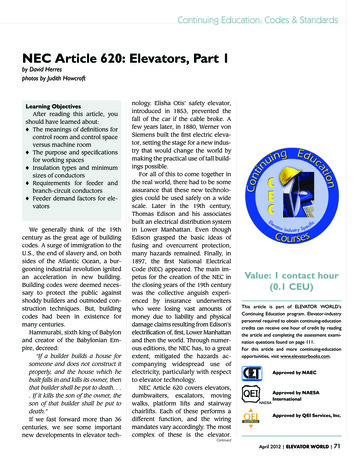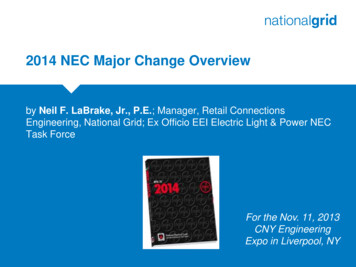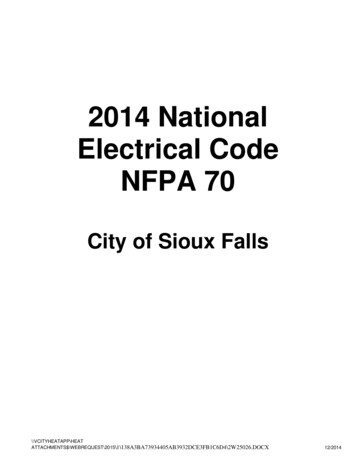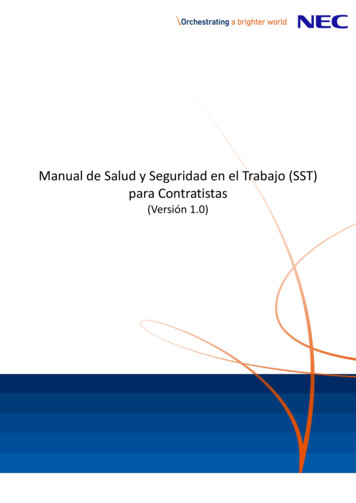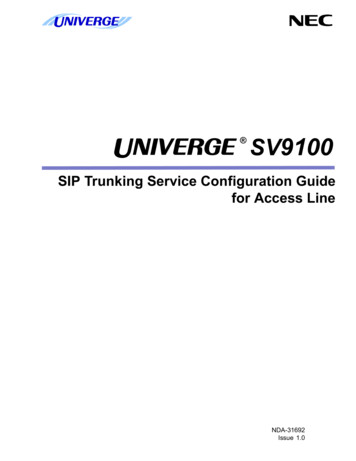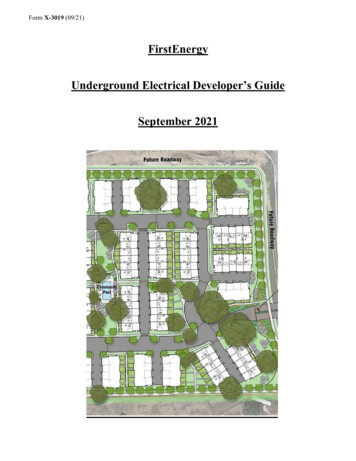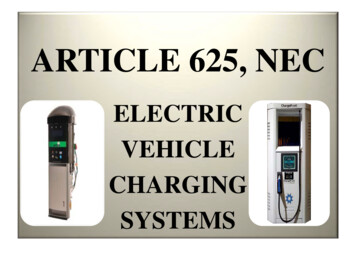
Transcription
ARTICLE 625, NECELECTRICVEHICLECHARGINGSYSTEMS
NEC ARTICLE 90.2(B)90.2(B) Not Covered. This Code does not cover:Installations in ships, watercraft other thanfloating buildings, railway rolling stock,aircraft, or automotive vehicles other thanmobile homes and recreational vehicles.
ARTICLE 625ELECTRIC VEHICLE CHARGINGSYSTEMS
HISTORY OF ARTICLE 625ELECTRIC VEHICLE CHARGINGSYSTEMSArticle 625 was entered into the NEC in 1996,covers the charging equipment external to thevehicle. It covers anything installed with eitherfeeders or branch circuits to charge the vehicle625.1 Scope. The provisions of this article cover the electricalconductors and equipment external to an electric vehicle thatconnect an electric vehicle to a supply of electricity by conductiveor inductive means, and the installation of equipment and devicesrelated to electric vehicle charging.
ELECTRIC VEHICLE SUPPLYEQUIPMENTEVSELEVEL 1Rated 110-120 volts-15 or 20 AmpsLEVEL 2Rated 208 or 240 Volts-20-100 AmpLEVEL 3Rated 480 Volts-60-400 Amps
LEVEL ONE CHARGERS-LEVITON
LEVITON LEVEL ONE CHARGERSCHARACTERISTICS1) 120 volt (1.5 kw) Primarily Residential HouseholdPower2) Permitted to be cord and plug connected3) Charge Time-approximately 8-20 hours
LEVEL2 GE WATT STATIONSCHNEIDER30 AMP/ 30208A/240V VHUBBELG.E.30A/ 24030 AMP/208VV
LEVEL TWO CAR CHARGERSCHARACTERISTICSRESIDENTIAL1) 240V Single Phase (6.524kW) 30-100ACOMMERCIAL1) 208 V Three Phase(14kW) 30 Amps2) Fixed in Place-MandatoryFixed in Place-Mandatory3) Charge Time: 4-8 HoursCharge Time: 4-8 Hours
TESLA S CHARGING SCALELEVEL 2#3 AWG#3 AWG#4 AWG#4 AWG#6 AWG#8 AWG#8 AWG
LEVEL 3 CHARGERSCHAdeMo (CHArge for Moving)
LEVEL THREE CAR CHARGERSCHAdeMo (CHArge for Moving)CHARACTERISTICS1) 480 Volts/30-40 Amps2) These chargers arerated to charge at 480volts and 400 amps3) 50-80% partial chargein a matter of 15-30minutes or so.Nissan mentions thatconstant Level 3charging of the Leafwould lower the rangewhile consistent Level2 charging wouldmaintain maximumcapacity.
LEVEL THREE CAR CHARGERSCHAdeMo (CHArge for Moving)
TESLA CHARGING STATIONSThe stations--faster than any othercharging stations in existence,according to Tesla--can provide up to100 kW (in the future, up to 120 kW)of power to EVs, juicing them up in 30minutes with enough power to drivefor three hours.
TESLA SIt’s no five-minutetrip to the gasstation, but we aregetting closer.Tesla’ssuperchargers offerpower for free forall Tesla S.
CHAdeMo CHARGING STATIONSJapan 1677 Europe 759 USA 160 Others 12
CHARGING IN 30 MINUTESSupercharging past thehalfway point slows downconsiderably. This is due to thebattery technology. The morefull the cells become, theslower the charging has to be,because charging is too fast,the cells become damaged.
ARTICLE 625ELECTRIC VEHICLECHARGING SYSTEMSPART 1 GENERAL PRIMARILY DEFINITIONSPART IIWIRING METHODSCOUPLERS625.9 (A) Polarization Of Coupler(B) Noninterchangeability Not Interchangeable with otherElectrical Systems(C) Construction and Installation Prevent Inadvertent contactBy Persons(D) Unintentional Disconnection Positive means of locking(E) Grounding Pole Provided Only if Coupler Requires(F) Grounding Pole Requirements If provided, shall be First toMake, last to Break
CHARGING COUPLER
ARTICLE 625.9(A)PRIMARILY MANUFACTURER’SRESPONSIBILITY
ARTICLE 625ELECTRIC VEHICLECHARGING SYSTEMSPART III EQUIPMENT CONSTRUCTION625.13 125V 15/20A EVSE Permitted to be cord and plug625.15(A) Marking. “For Use with Electric Vehicles”625.16 Means of Coupling. Coupling Listed and labeled forthe Purpose625.18 Interlock. De-energize when uncoupled. Not required for120v Single Phase Systems625.19 Automatic De-Engergization of Equipment De-energizecable conductors & connector whenexposed to strain. Applies to portable 120v equipment.
DE-ENERGIZE CHARGER IFUNCOUPLED FROM VEHICLE
ARTICLE 625ELECTRIC VEHICLECHARGING SYSTEMSPART IV CONTROL AND PROTECTION625.21 Overcurrent Protection rated 125%.“Continuous Duty”Considered625.22 Personnel Protection System-EV supply equipment shallhave listed protection against personnel shock625.23 60 A/150 V Disconnect-Readily AccessibleLockable in the Open Position-Permanent625.25 Loss of Primary Source-No back feeding fromfrom Vehicle during Utility Outages
DISCONNECT READILYACCESSIBLE IF OVER 60 A ormore than 150 V to Ground
“Circuit breaker used as the disconnectingmeans shall remain in place with or withoutthe lock installed”
ARTICLE 625ELECTRIC VEHICLECHARGING SYSTEMSPART V ELECTRIC VEHICLE SUPPLYEQUIPMENT LOCATION625.29 Indoor Sites. Integral, attached, detached garageenclosed, underground parking structures625.29(A) Location. Permit direct connection of vehicle(B) Height No lower than 18”-no higher than 4’(C) Ventilation Not Required-Listed as nonvented storage batteries for indoor charging
18” Off Ground, No Higher than 4’
ARTICLE 625ELECTRIC VEHICLECHARGING SYSTEMSPART V Continued.(D) Mechanical Ventilation (fan) for indoor charging625.30 Outdoor Sites. Residential Car Ports, drivewayscurbside, parking structures, parking lots(A) Location. EVSE located to permitconnection(B) Height. Not less than 24” and not greater4’
ARTICLE 100DEFINITIONSDOES THE DEFINITIONOF A SEPARATESTRUCTURE APPLYTO FREE STANDINGCHARGERS(COMMERCIAL) ORCHARGERSINSTALLED INDETACHEDGARAGES(RESIDENTIAL)SEPARATE STRUCTURE“That which is builtor constructed.”
ARTICLE 250.32BUILDINGS OR STRUCTURES SUPPLIED BY AFEEDER(S) OR BRANCH CIRCUIT(S)
LEVEL 3 CHARGER WITHGROUND RODS-SEPARATESTRUCTURE
LEVEL THREE CHARGEROVER 60 Amps/150 v to Ground
SOLAR CAR PORTSRESIDENTIALCOMMERCIAL
BOLLARDS
NEWFOR2011 NEC
END OF PRESENTATION
Article 625 was entered into the NEC in 1996, covers the charging equipment external to the vehicle. It covers anything installed with either feeders or branch circuits to charge the vehicle 625.1 Scope. The provisions of this article cover the electrical cond


